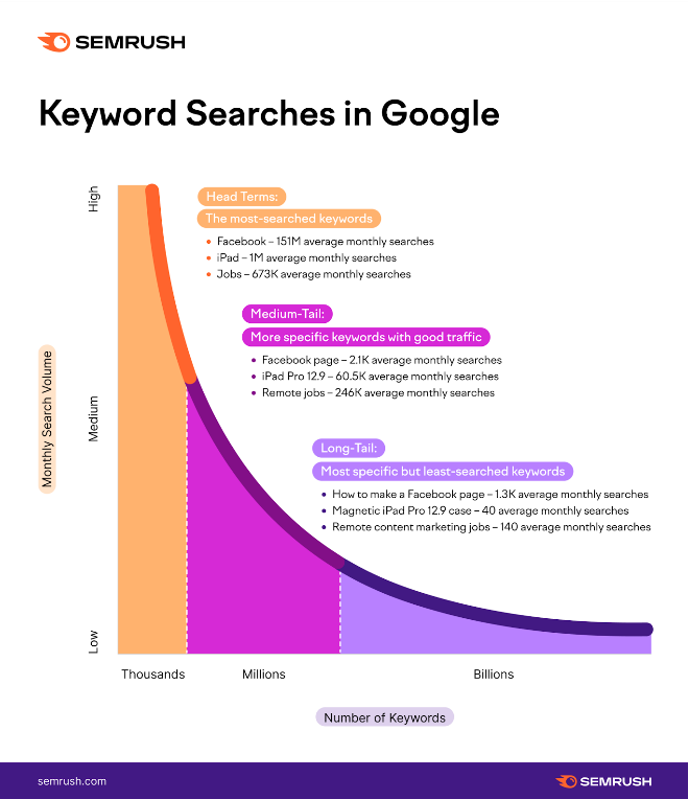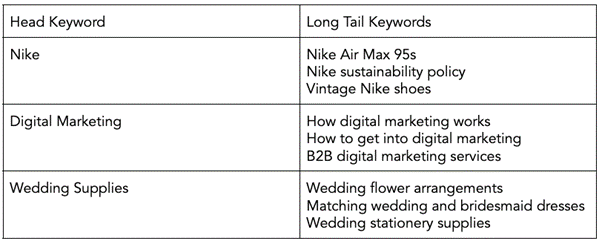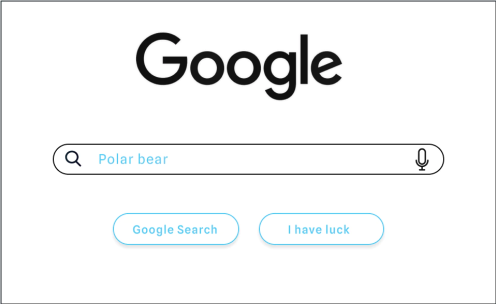In the dynamic realm of digital marketing, understanding and effectively utilising Search Engine Optimisation (SEO) can be a game changer for businesses and content creators.
Within the SEO toolkit, one powerful but often underutilised tool is using long-tail keywords.
A long-tail keyword strategy can help you out if there’s a lot of competition in that market, especially as it can help you attract visitors with a specific search intent.
In this article, we’ll aim to unpack the importance of long-tail keywords in SEO and provide practical insights into leveraging them for improved search engine visibility.
What is a Long Tail Keyword?
A long tail keyword is essentially a highly specific search phrase that has three or more words. They often have low search volume and competition but high search intent meaning.
It often targets niche demographics rather than mass audiences and tends to be more descriptive and detailed than shorter, generic keywords.
As these keywords are more descriptive, these terms are generally used toward the end of the sales funnel to drive conversions.

Example of Long Tail Keywords
To illustrate, let’s compare a standard keyword with a long tail one. A general keyword might be “bicycles,” but a long tail version could be “black bicycles for women for under £500”.
The latter not only specifies the gender but also the type of bicycle and price range, catering to a specific market segment.
This specificity is at the heart of what makes long tail keywords valuable.

Why Are Long Tail Keywords Important in SEO?
There are many reasons why long tail keywords are important in SEO. Here are some reasons why:
Reduced Competition
Since they are more specific, long tail keywords often have less competition. This is especially beneficial for new or smaller websites that may struggle to rank for more competitive terms.
The aim is to find reliable long tail keywords that are right for your business’s niche.
Increased Content Visibility
Long tail keywords can also help your content marketing strategy. Whenever someone searches for a keyword, Google will produce personalised results based on the following factors:
- Interactions
- Language settings
- Location
- Search History
This means that Google could produce two different results if two people are searching for the same keyword at the same time. Long tail keywords can play a big part here and optimise your content for various user segments.
For example, let’s say someone types in the keyword ‘blue jeans’ as this isn’t specific to a particular audience, so Google may list this with blue jeans for adult men within that searcher’s country. This keyword will now become a very competitive keyword.
Using more specific keywords will help ensure your content is on display for a particular demographic.
Targeted Audience
Long tail keywords attract users who are searching for specific items. Such users are often closer to the point of purchase, making them more valuable for businesses.
This means they can align more closely with the intent of the searcher, leading to higher conversion rates.
Improved Blog Strategy
Blogging can be a crucial feature of your content marketing strategy, to boost visibility and drive a lot of traffic to your website.
Implementing long tail keywords into your strategy will help you explore a broader range of topics related to your business. If you’re able to go one step further and diversify your topics, you will be able to establish your blog as an authoritative source in Google’s eyes.
Voice Search and Natural Language
With the increasing use of voice search, natural language queries are becoming more common. Long tail keywords often mirror how people speak, making them more relevant in voice searches.
For voice search, question-based queries are the real heroes for your content. Adding question words such as ‘what,’ ‘why,’ and ‘how’ can allow Google to suggest further voice search queries.
For example, if you want to type ‘voice search’ into Google, and you put the word ‘what’ before it, Google has suggested the phrase ‘what is voice search optimisation.’
Answer the Public is also a great keyword research tool to help you map out long tail keywords that are relevant to your voice search.

How to Find Long Tail Keywords for Your Website
Finding long tail keywords can be an extensive process, but can be very rewarding if you know how to find them. Here are some of the best ways to find keywords for your website:
Leverage Keyword Research Tools
Utilise tools like Google’s Keyword Planner, SEMrush, Ahrefs, or Moz Keyword Explorer to find long tail variations of your main keywords.
These tools offer filters to identify less competitive keyword phrases. When conducting research, you should also look at the keyword difficulty, as lower difficulty means less competition.
Check Related Queries
If you type a short keyword into Google, you may find that your query is too broad.
However, if you scroll to the bottom of Google’s SERP, you’ll find a list of search suggestions related to your query.
You can use these to make your original keyword more specific and to a range of sub-topics.
Explore Competitors
Analyse your competitors’ content and SEO strategies to identify the long tail keywords they are targeting.
Conducting a gap analysis or an SEO audit using competitors could allow you to discover gaps in your content or find further keyword opportunities for your content strategy.
Monitor Trends
Stay updated with industry trends and emerging topics. Tools like Google Trends can be helpful in identifying new long tail keywords.
It lets you see the latest trends, data, and visualisations from Google. You can explore what’s trending near you or discover how popular a search term is compared to another.
This is essential for identifying emerging topics that are gaining traction among your target audience.

How to Use Long Tail Keywords
There are a variety of ways you can implement long tail keywords in your content, such as:
Consider the Search Intent
Understanding search intent is the first step in effectively using long tail keywords. Search intent refers to the purpose behind a search query.
Is the user looking to buy something, looking for a specific website, or simply seeking information?
There are typically four types of search intents: informational, navigational, transactional, and commercial investigation.
- Informational Intent: Here, users are looking for information. For example, “how to bake a chocolate cake.”
- Navigational Intent: Users with this intent are trying to get to a specific website or page, like “Facebook login.”
- Transactional Intent: This is when a user is ready to buy and might use keywords like “buy iPhone 12 online.”
- Commercial Investigation: Users are considering a purchase and are researching their options, for example, “best DSLR cameras 2024.”
By identifying the search intent, you can tailor your long tail keywords to match these intents more precisely, making your content more relevant and easily discoverable.
Create Topic Clusters
Topic clusters are a method of organising your website’s content pages using a cleaner and more deliberate site architecture.
For long tail keywords, topic clusters work exceptionally well. You can start by identifying a broad topic, then create cluster content based on long tail keywords that are relevant to this topic.
For instance, if your main topic is “organic gardening,” your long tail keywords could be “best organic fertilisers for vegetables,” “organic pest control methods,” or “beginner’s guide to organic gardening.”
Carefully Place Your Keywords
Once you have your long tail keywords and understand their intent, it’s crucial to place them strategically within your content.
This doesn’t mean stuffing your content with as many keywords as possible. Instead, it involves placing them in key parts of your content where they have the most impact.
- Title and Headings: Include long tail keywords in the title and subheadings. This not only helps search engines understand what your content is about but also tells readers they’ve found what they’re looking for.
- First 200 Words: Make sure to use your keyword naturally in the first couple of paragraphs.
- Throughout the Content: Use variations and synonyms of your keyword throughout the content to avoid repetition and maintain reader interest.
- Meta Descriptions and URLs: Incorporating long tail keywords into meta descriptions and URLs can further optimise your content for search engines.
Get More Advice on Long Tail Keywords
Staying informed and continuously learning is key to effectively utilising long tail keywords.
By focusing on these specific, targeted phrases, you can effectively reach your desired audience, improve your search engine rankings, and drive more meaningful engagement with your content or products.
Contact us for more information on implementing long tail keywords in your SEO strategy.












